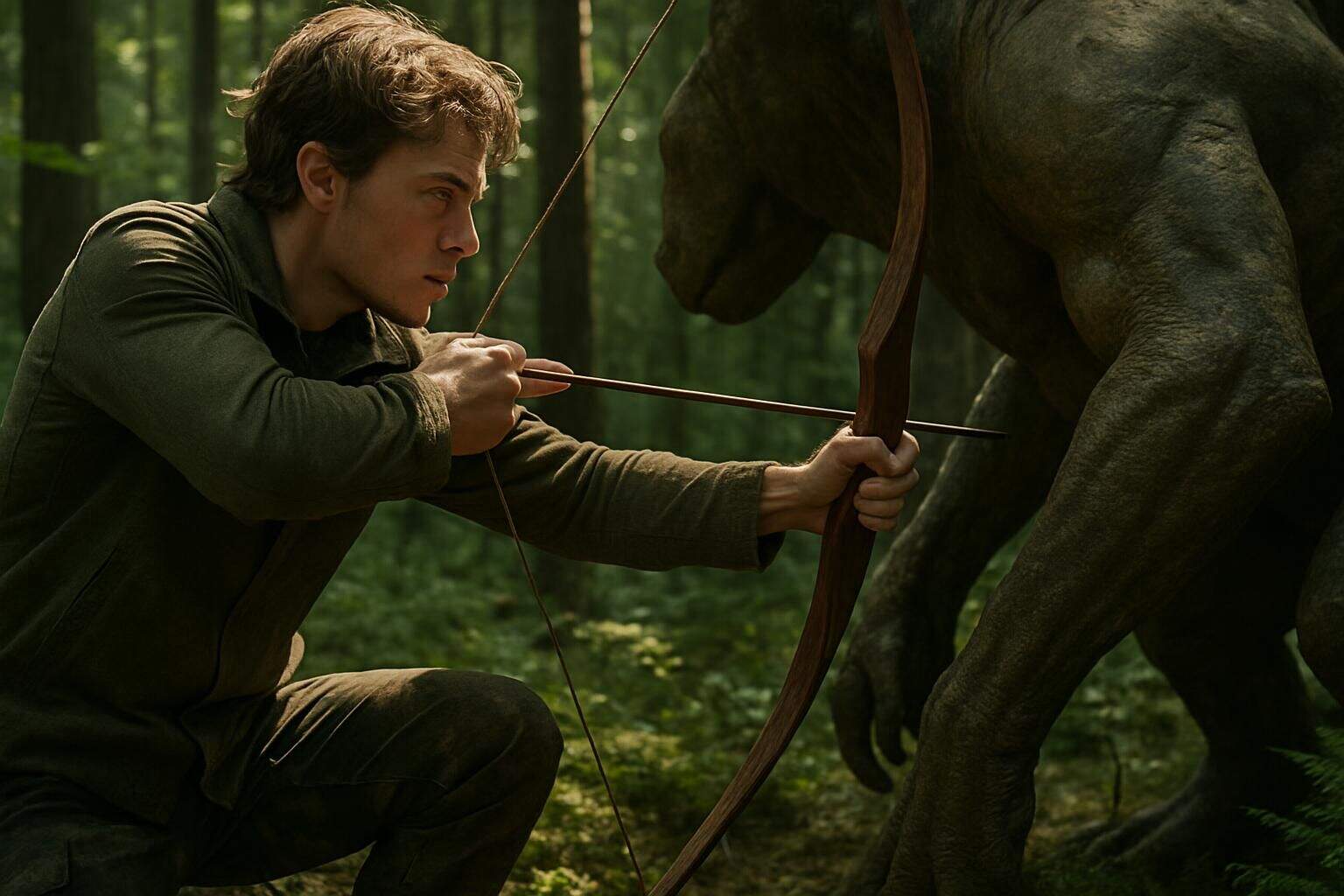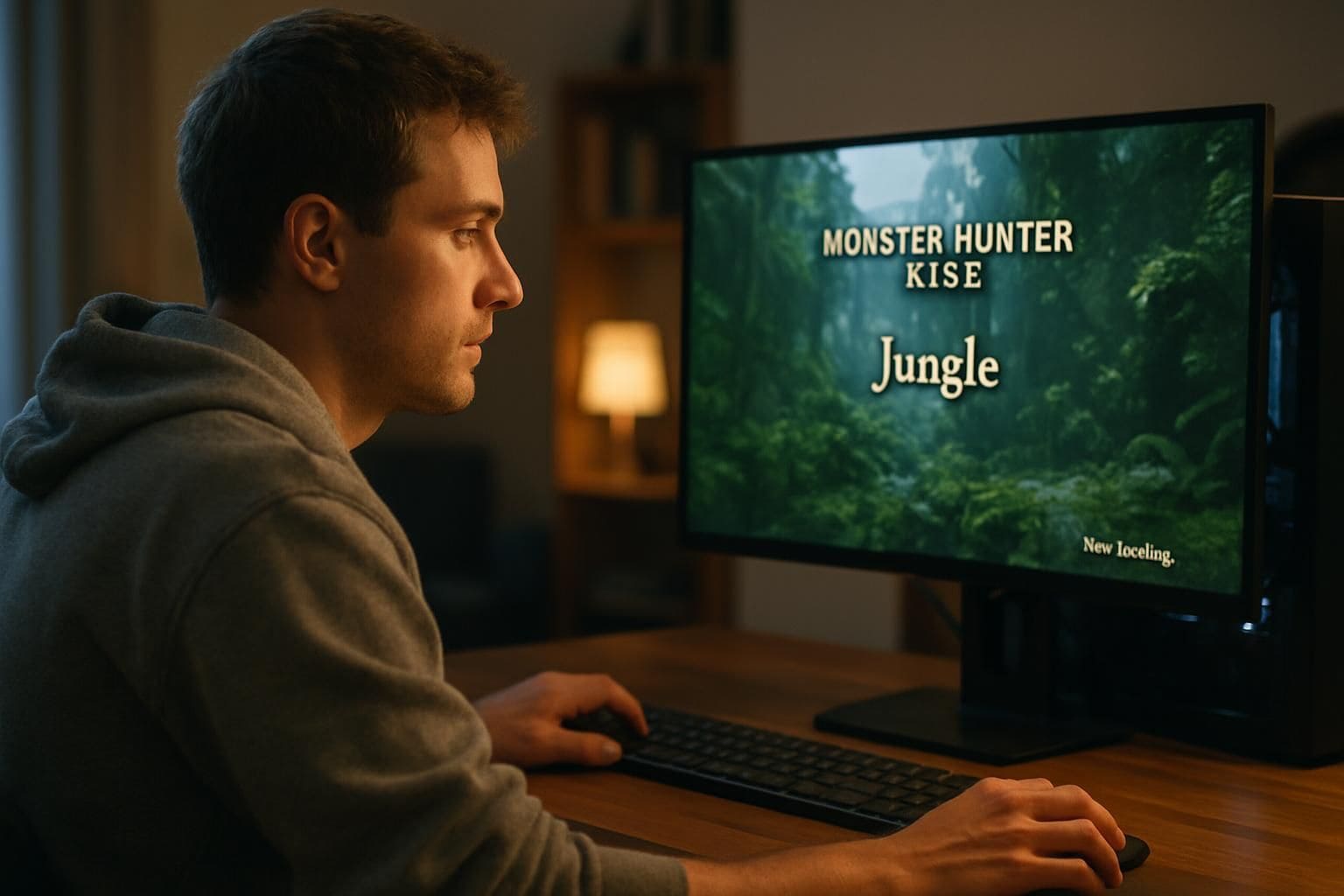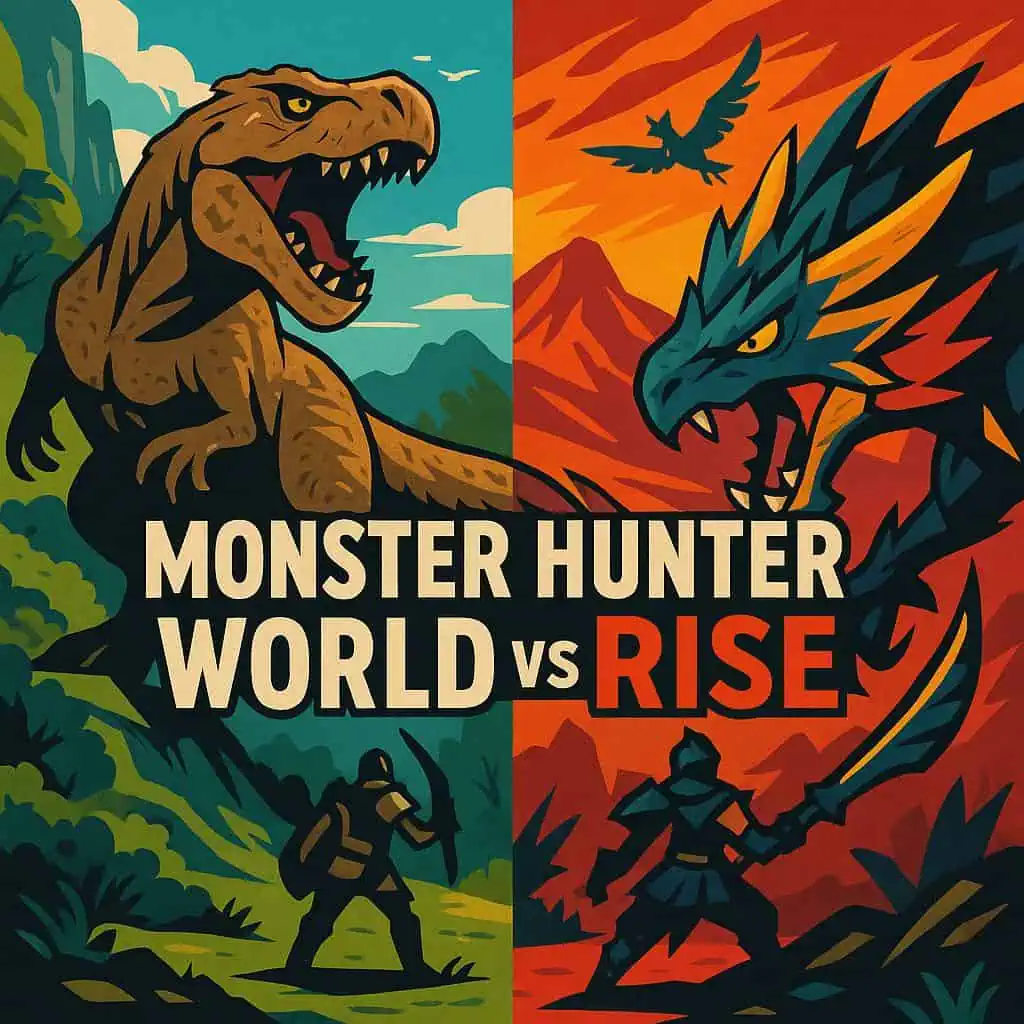Many gamers feel stuck deciding between Monster Hunter World vs Rise, unsure which game suits their play style. Monster Hunter World offers deep exploration and immersive gameplay, while Monster Hunter Rise focuses on fast-paced combat mechanics built for quick action.
This guide clearly compares 9 big upgrades coming by 2025 to help you pick the right fit for your next hunt. There’s much more ahead, so read on!
Key Takeaways
Monster Hunter World lets players explore vivid, detailed landscapes that feel alive, while Rise offers speedy gameplay—you can zip around quickly using the Wirebug for swift movement.
Rise loads maps in just a few seconds, unlike World’s longer loading screens, and the PC version runs smoother, with higher frame rates than on consoles.
World’s Iceborne expansion hit an impressive 14 million copies sold, giving fans around 570 hours of total playtime; Rise’s Sunbreak expansion reached 8.8 million copies, with roughly 135 hours of content.
World delivers smoother online gameplay through the handy SOS flare feature, but Rise sometimes struggles with online connection errors—still, Rise does offer useful offline options.
Rise lets newcomers pick up the game easily, but World rewards skilled players who learn and master deeper, more precise combat systems.
Table of Contents
Gameplay and Mechanics

Monster Hunter games shine through their deep combat systems and rich worlds to explore. Each title brings unique twists to the formula, with World’s clutch claw changing how hunters tackle monsters and Rise adding new mobility options.
Combat Systems
Monster Hunter World Steam brings combat alive with satisfying sound effects, making each strike feel solid and impactful.
Scoutflies help hunters chase down elusive monsters through dense and detailed surroundings. Players who purchased Monster Hunter World Steam keys quickly realized multiplayer wasn’t optional—it formed the core of gameplay.
Teaming up with close friends or joining hunters across continents creates a sense of shared excitement, making cooperative hunts integral to the fun. This focus on multiplayer even reshaped how action RPGs handled cooperative gaming, turning it into a central gameplay element.
Rise takes a new direction by introducing the Wirebug system. Hunters can swing through the landscape swiftly, opening up fresh combat moves and impressive aerial maneuvers unseen in World.
Fans enjoy Rise, praising its sharper weapon handling and improved accuracy during fights. With the Wirebug, players quickly cover vast distances, instantly changing their combat strategies against towering monsters.
These adjustments alter how each hunt plays out, forcing players to adapt quickly against enemies of all sizes. We’ll soon check out both games’ approaches to map layout and exploration.
The true mark of a hunter isn’t just in their gear, but in how they master the tools given to them – whether it’s World’s clutch claw or Rise’s wirebugs.
Exploration and World Design
Combat systems shape how players handle monsters—but a game’s environment truly sets the hunting mood. The designs differ widely between Monster Hunter World and Rise. In Monster Hunter World (MHW), lush settings encourage thoughtful exploration.
Players must follow monster trails through dense forests and scorching deserts before making their move. Because of this slower rhythm, the hunt feels very real—especially on PlayStation consoles and PC gaming setups.
Rise opts for a faster pace with its environments. Hunters use handy Wirebugs to quickly zip around and scale terrain. Vertical movement becomes simple, letting players explore easily on Nintendo Switch or Steam.
They swiftly reach hidden places and out-of-sight areas. Village quests also blend seamlessly into the world in Rise, connecting locations and quests naturally. Each game crafts distinctive hunting areas—Rise favors quickness, while World leans into patience and careful tracking.
Enemy AI and Behavior
Exploring Monster Hunter isn’t just about roaming vast landscapes—it’s the incredible AI-driven creatures that really bring the adventure to life. Monster Hunter World raised the bar, introducing monsters that behave like genuine animals.
Without any player influence, these beasts hunt, rest, and even clash with other creatures. Injured monsters don’t just keep fighting; they limp away and find a spot to recover.
Monster Hunter Rise takes this even further, making monster activities feel extra realistic and unpredictable. Now, some creatures cleverly turn your own wirebug tactics against you, forcing you to sharpen your skills and adapt quickly.
Rise expands turf battles too, making monster-on-monster conflicts feel genuinely wild and spontaneous. The detailed AI truly stands out on powerful graphic cards like GeForce or AMD Radeon—but even on Nintendo Switch, Rise feels smooth and looks good.
Smart, lifelike monster behaviors turn every hunt into an authentic wildlife chase, instead of simply fighting predictable game foes.
Graphics and Visuals

Monster Hunter World and Rise both push the limits of visual design with their unique art styles. The games offer stunning landscapes and monster details that make each hunt feel real and exciting.
Environmental Details
Monster Hunter World delivers incredible scenery full of vivid details that make every zone feel lively and natural. Trees gently sway in the breeze, waterfalls sparkle and flow, and tiny wildlife scampers around, minding its own business.
The game relies on Nvidia technology to produce intricate shadows and lighting effects that shift naturally from daylight to nighttime. I even spent hours simply staring at sunlight streaming through thick jungle leaves deep inside the Ancient Forest.
The central hubs in MHW draw you into their reality with lifelike elements—steam drifting upward from freshly cooked dishes, or villagers casually going about their everyday chores.
Rise follows a different artistic route due to hardware limits on the Nintendo Switch. Its environments show fewer small touches—but compensate beautifully with bright colors and creative designs.
Though less graphically detailed than World, Rise offers stunning scenery inspired by traditional Japanese myths and legends. Town hubs pop with charm thanks to clever design instead of raw graphical power.
During my sessions, I noticed how clever art choices allowed Rise to work around hardware restrictions, crafting striking settings that stand out clearly in memory.
Character Models and Animations
Both games offer huge improvements in how hunters and creatures appear and move. In Monster Hunter World, creatures have remarkable details—scales shine clearly, fur ripples realistically, and both change based on water or mud.
The armor pieces on hunters stand out with detailed patterns, showing off the high quality of Japan’s gaming industry in Japan.
Rise moves toward a slightly different style, more artistic and colorful, yet still offering smooth and natural movements. In my more than 200 hours with Rise, I noticed how the wirebug mechanics add smooth acrobatics right into the fighting.
Even weapon attacks feel smoother and more accurate, thanks to improved hitboxes.
The difference between World and Rise isn’t just graphics, it’s how each game makes its monsters feel alive through movement and behavior.
Quick loading times also matter—they help you jump straight into the action—which leads right into how performance differs across systems.
Load Times and Performance

Monster Hunter games have made huge strides in cutting load times, with Rise loading maps in seconds compared to World’s longer waits. Players can now jump into hunts faster on all systems, with PC versions offering the smoothest experience at higher frame rates.
Optimization on Different Platforms
Monster Hunter games perform differently depending on the gaming platform, and these performance gaps truly impact serious hunters. Here’s a quick breakdown to help you decide what suits you best:
- PC editions of Monster Hunter World consistently deliver the smoothest gameplay, regularly reaching over 60 FPS if your graphics card is strong enough—but base PS4 models often dip below 30 FPS during crowded fights and large hunts.
- Monster Hunter Rise offers steady 30 FPS on Nintendo Switch, with only minor dips—Capcom’s RE Engine clearly fits well with the Switch’s portable hardware.
- Rise on the Switch noticeably trims waiting time between hunts, loading almost twice as fast as Monster Hunter World on a PS4.
- Steam players see even quicker results with Monster Hunter Rise, especially using SSD drives—Rise loads hunts in under 5 seconds compared to Switch’s 15-20 second average.
- PS4 Pro gives Monster Hunter World fans a “Performance Mode” option that holds frame rates steadier, helping maintain a smoother experience during tough monster encounters.
- PC gamers can freely adjust graphics settings for both titles, but Monster Hunter World demands significantly stronger hardware compared to Rise at higher settings.
- Monster Hunter World: Iceborne expansion pushed base console performance harder, causing noticeable slowdowns and frame dips, particularly with intensive monster attacks.
- Valve’s Steam Deck smoothly runs Monster Hunter Rise at medium settings, offering a convenient and portable co-op hunting experience on the go.
- Console players saw significant performance boosts through regular updates—Monster Hunter World received six major optimization patches in just its first year.
- Input lag in Monster Hunter Rise feels noticeably reduced across every platform, providing quicker, snappier combat compared to Monster Hunter World, no matter the device used.
Speed and Efficiency
Monster Hunter Rise truly impresses with ultra-fast load times on Nintendo Switch. Players leap into hunts within seconds, far quicker than the minutes-long waits experienced in World on PS4.
This speedy loading time keeps momentum high and downtime minimal—keeping players locked into the action.
Time spent in loading screens is time not spent hunting monsters.
Rise introduces the Wirebug, a movement tool that completely changes how hunters explore game areas. Using Wirebugs, players swiftly glide around the map or quickly bounce back into combat after a hit.
The game emphasizes smooth, direct action, making multiplayer hunts effortless and enjoyable. Rise’s optimized design helps matches run without annoying technical pauses—a detail fans clearly value, judging by Rise: Sunbreak’s popularity on Steam.
Content and Expansions

Both Monster Hunter World and Rise pack tons of extra content through their major expansions. Iceborne and Sunbreak add new monsters, weapons, and areas that extend gameplay for hundreds of hours.
Monster Hunter World: Iceborne
Monster Hunter World: Iceborne became a massive smash hit, selling over 14 million copies globally. Completionists can spend up to 570 hours finishing every bit of the expansion—on top of around 80 hours for the original story.
Personally, I lost track of how many nights I spent tracking tougher beasts through icy wastelands. Iceborne also introduces the clutch claw mechanic, letting you grapple monsters directly for more dynamic battles.
But Iceborne offers way more than extra creatures to hunt. It deepens the entire Monster Hunter experience through rich, lifelike ecosystems where monsters interact naturally. Steam charts revealed a huge spike in player numbers right after Iceborne’s launch, as gamers rushed into the fresh content.
Areas introduced by this expansion rival—and sometimes outshine—the main game in sheer size and detail. Many fans see Iceborne as the perfect example of DLC done right, with content and value that feel like a whole new game.
Monster Hunter Rise: Sunbreak
Iceborne lifted World to impressive new levels, but Sunbreak’s impact on Rise landed with mixed fan reviews. Still, Sunbreak managed to sell a solid 8.8 million copies—an impressive figure, even though many players found it lacked the magic of Iceborne.
Sunbreak added the Anomaly Investigations mode, giving dedicated hunters an extra endgame thrill after finishing the main storyline.
Sunbreak adds depth to Rise, but doesn’t quite reach the heights that Iceborne did for World.
Rise’s main quest line wraps up in about 20 hours of gameplay. But for those aiming to do everything, expect around 135 hours to fully conquer every hunt and mission available. Teaming up with friends remains central to Rise’s gameplay—the fun of teaming up and bringing down the biggest beasts hasn’t changed.
The HTML interface received small but helpful improvements, simplifying the way groups join multiplayer hunts across different gaming platforms.
Multiplayer Experience
Monster Hunter’s multiplayer hunts offer the best way to tackle tough beasts with friends. Both World and Rise shine with drop-in co-op, but Rise speeds up the joining process while World creates deeper shared adventures.
Co-op Features
Monster Hunter World has an excellent SOS setup that makes joining hunts a breeze. Players can shoot an SOS flare mid-quest, allowing others to quickly hop in and lend a hand against challenging beasts.
Fans often prefer World’s streamlined SOS system compared with Rise’s less effective, sometimes clunky matchmaking system. Still, Rise offers helpful upgrades to its multiplayer gameplay.
You don’t have to sit through lengthy cutscenes anymore before friends can join—something pretty annoying in World. Rise also introduces offline event quests and follower mods, giving you NPC buddies who step in, whenever real players can’t help out.
I’ve spent tons of hours teaming up with friends in both games; honestly, the differences become pretty clear. World gives off a classic multiplayer feel, offering smooth and effortless SOS matchmaking.
Rise, on the other hand, succeeds at creating a more relaxed, flexible co-op atmosphere. Multiplayer has always been the main strength in Monster Hunter—with friends banding together to face giant monsters, creating truly memorable game nights.
Online play strongly shapes these exciting monster battles, impacting each player’s adventure and overall enjoyment.
Online Connectivity
Monster Hunter World stands out with its excellent SOS flare feature, a big hit with many players. This system lets hunters instantly send for backup during challenging fights—and other players can jump right into the action.
MHW’s matchmaking runs smoothly, helping hunters quickly team up without frustration. In contrast, Rise has received complaints about weak online performance. Players often experience connection errors, delays, and lengthy waits for teammates.
Both games offer multiplayer modes, but World clearly provides a smoother online experience. Servers in MHW handle heavy player traffic well, rarely dropping players—even in heated monster battles.
Rise does provide useful offline features, including event quests that hunters can tackle anytime, along with NPC partners through follower mods. These options come in handy during internet outages, but they fall short of fixing the main online issues plaguing Rise.
Accessibility for New Players
Monster Hunter has made huge strides in welcoming newcomers to the hunt. Both World and Rise offer better tutorials and gentler learning curves than past games in the monster hunter series.
Difficulty Levels
Monster Hunter Rise gives players an easier, friendlier learning curve compared to World. I played both games and found Rise simpler to pick up and jump right into. Rise boosts combat speed and mixes in fresh ways to move, helping you dodge monster strikes smoothly.
Quests are less tricky, battles less brutal, and the overall experience suits casual gamers well. With these gameplay shifts, even exploring out in the wild feels less stressful.
Monster Hunter World delivers harder, slower-paced challenges that reward careful play styles. Its slower rhythm makes players study monsters closely, figuring out attack patterns and weak spots.
World’s late-game grind includes demanding investigations, tough enough to stretch even seasoned hunters. Balanced difficulty is always part of the Monster Hunter experience, but World clearly encourages deeper mastery of its mechanics than Rise does.
Next up, we’ll explore how each title introduces newcomers to its more detailed systems.
Tutorials and Onboarding
Tutorials set the tone for players learning the ropes—and difficulty settings shape the overall challenge. The approach to teaching players changed significantly between Monster Hunter World and Monster Hunter Rise, each taking its own route to guide newcomers.
Tutorials and Onboarding
- Monster Hunter World slowly introduces players to mechanics, offering clear weapon tutorials that allow practice before stepping into real fights.
- Rise speeds things along, providing quicker tutorials—but often breezes past essential points, leading many first-timers to struggle during the demo phase.
- World’s training area lets players freely test out all 14 weapon categories, complete with detailed move lists and clear combo examples, helping players pick their preferred style early on.
- Rise introduces handy switch skill tutorials later in the game, clearly outlining fresh combat mechanics and alternate move-sets.
- Rise greatly improved the Hunter Notes section, adding easier-to-understand monster weakness charts and clearer visual crafting guides.
- Both titles have trouble clearly teaching in-depth mechanics like elemental damage or affinity; players frequently need to rely on outside guides for extra clarity.
- World’s main story missions also function as tutorials, clearly demonstrating monster tracking, capturing methods, and combat scenarios across varied environments.
- Rise offers follower quests, putting helpful NPC partners into hunts who actively demonstrate smarter hunting strategies and act like practical mentors during gameplay.
- Co-op tutorials in World are thorough and useful—they clearly demonstrate joining hunts through SOS flares and teamwork during battles with larger creatures.
- Monster Hunter Wilds aims to improve on these earlier systems, adding an AI hunting partner that provides dynamic guidance to walk beginners through both foundational knowledge and advanced hunting techniques.
Portability and Platforms
Monster Hunter games now span across many gaming systems, from handheld to high-end PCs. Each platform offers unique ways to play, with the Switch version letting you hunt monsters on the go while PC and console versions focus on graphics power.
Console and PC Options
Monster Hunter World really shines on powerful systems like PC, Xbox One, and PlayStation 4. These platforms offer stunning graphics, crisp textures, and smooth, stable frame rates.
PC gamers have an extra edge—like custom mods and advanced graphic settings—that console users miss out on. Multiplayer gameplay stays fluid and responsive across every system, perfect for teaming up to hunt giant creatures.
On the other hand, Monster Hunter Rise goes a different route by focusing on Nintendo Switch. This portable choice lets players hunt monsters practically anywhere—on your couch, during lunch breaks, even on a bus ride home.
Despite limited hardware, Rise still runs smoothly, providing a reliable gaming experience. Later, Capcom released Rise on PC, bringing improved graphics and smoother performance, giving you more gaming options.
Both titles support strong online multiplayer, and your ideal platform simply depends on what matters most to you—high-powered visuals or portable play.
Nintendo Switch vs Other Platforms
The Nintendo Switch carved out a unique position in the Monster Hunter ecosystem with Rise, while other platforms showcase World’s visual prowess.
| Platform | Monster Hunter Title | Pros | Cons |
|---|---|---|---|
| Nintendo Switch | Monster Hunter Rise | • Play anywhere with portable mode • Instant local multiplayer with Joy-Cons • 30 FPS performance stays mostly stable • Faster load times than World on base consoles | • Lower resolution (720p handheld, 1080p docked) • Reduced texture quality and detail • Smaller environments with loading zones • Less atmospheric lighting effects |
| PlayStation 4/5 | Monster Hunter World | • Superior graphics with 4K support on PS4 Pro/PS5 • Enhanced lighting and particle effects • Richer environmental details • Stable 30 FPS (PS4) or 60 FPS (PS5) | • No portable option • Longer initial load times • Requires TV/monitor setup • More power consumption |
| Xbox One/Series X|S | Monster Hunter World | • 4K visuals on Series X • Quick Resume feature on Series X|S • Enhanced backward compatibility • Game Pass availability (periodically) | • No portable option • Similar limitations to PlayStation • No exclusive Monster Hunter content • Smaller player base than PlayStation |
| PC | Both World and Rise | • Highest possible graphics settings • Mod support for both games • Uncapped framerates • Portable via Steam Deck | • Higher cost entry point • More technical issues and setup required • Steam Deck battery life concerns • Delayed release schedule vs consoles |
I’ve played both games across multiple platforms, and the Switch version of Rise feels like a technical miracle despite its limits. The ability to hunt monsters during my daily commute changed how I approach the game. Let’s examine how these games can expand their content and keep fans engaged through expansions.
How Will Monster Hunter Evolve in 2025?
Monster Hunter fans, get ready—2025 is shaping up big. Capcom is set to launch its next major release, Monster Hunter Wilds, building on everything players loved about Monster Hunter World.
We got the first look at this exciting addition during the Tokyo Game Show, revealing sharper graphics and smoother gameplay.
For hunters, April 3, 2025, is a date worth marking. Title Update 1 debuts that day, bringing new content and fresh adventures. Rumors hint at Lagiacrus—an iconic monster from earlier games—making a comeback.
Fans might finally see underwater combat returning, a popular but long-absent gameplay feature from past titles.
Performance-wise, Monster Hunter Wilds promises serious improvements. Recent updates already boosted frame rates by around 15-20%, proving Capcom cares about smooth, enjoyable multiplayer experience.
Gamers encountering technical troubles can quickly find helpful tips from community-driven guides on Discord or Reddit. Both resources provide useful advice for optimizing the game, covering different console and PC setups.
Capcom clearly knows that great visuals and reliable performance matter equally—especially during action-packed multiplayer hunts against giant beasts.
People Also Ask
What makes Monster Hunter World and Rise different from each other?
Monster Hunter World delivers realistic visuals and expansive maps to explore, while Rise focuses on swift gameplay and dynamic movement abilities. Plus, World’s Iceborne expansion brings huge new locations and monsters, which Rise hasn’t matched yet.
Can I team up with friends in Monster Hunter World and Rise?
Yes, each game offers co-op play, so you can hunt monsters alongside up to three friends. Although the multiplayer modes aren’t exactly the same in each title, both focus strongly on a fun, cooperative experience.
Which title offers stronger endgame content?
Currently, Monster Hunter World—with its Iceborne expansion—has stronger endgame challenges. Iceborne introduces tougher monsters like tempered and arch-tempered beasts, rewarding experienced hunters with top-tier gear.
Will the 2025 upgrades make Monster Hunter World and Rise compatible?
The planned 2025 upgrades won’t enable cross-play between World and Rise. Still, the updates will upgrade co-op experiences and streamline team hunts. Experienced Iceborne hunters will enjoy smoother gameplay, while new players will find the game easier to jump into.
References
https://gamefaqs.gamespot.com/boards/264562-playstation-5/80429044
https://gamerant.com/monster-hunter-rise-world-comparison-which-better/
https://rpgcodex.net/content.php?id=12405 (2024-08-24)
https://gamerant.com/monster-hunter-world-popular-rise-environment-details-map-design/ (2024-01-14)
https://steamcommunity.com/sharedfiles/filedetails/?id=3436896664
https://gamefaqs.gamespot.com/boards/211368-monster-hunter-world/79404432 (2021-04-14)
https://www.theverge.com/2019/9/6/20852558/monster-hunter-world-iceborne-review-ps4-xbox
https://www.facebook.com/groups/SwitchCommunity/posts/2139902316474030/
https://steamcommunity.com/app/582010/discussions/0/4148445959733564411/ (2024-01-25)
https://steamcommunity.com/app/582010/discussions/0/734750050411895681/
https://www.thegamer.com/monster-hunter-wilds-depth-diffculty-capcom-approachability/
https://steamcommunity.com/app/1446780/discussions/0/594011345717855797/
https://www.washingtonpost.com/video-games/reviews/monster-hunter-rise-review/
https://9meters.com/entertainment/games/monster-hunter-wilds-first-major-update-announced (2025-03-26)
